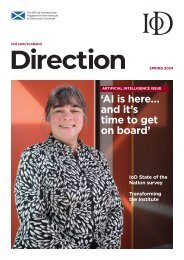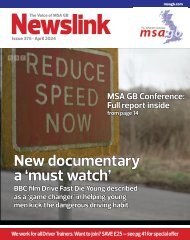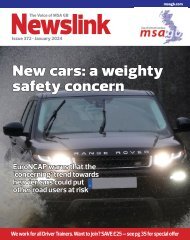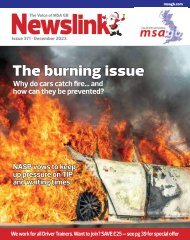Newslink October 2021
Membership magazine of the Motor Schools Association; road safety, driver training and testing news.
Membership magazine of the Motor Schools Association; road safety, driver training and testing news.
You also want an ePaper? Increase the reach of your titles
YUMPU automatically turns print PDFs into web optimized ePapers that Google loves.
Special feature: Vehicle lights<br />
Continued from page 23<br />
Detection, Conspicuity and DRL<br />
Generally, the greater the contrast<br />
between the vehicle and its background<br />
the greater the probability it will be<br />
detected. For light coloured cars, the<br />
contrast is generally greater than for dark<br />
coloured cars. But the contrast of a light<br />
coloured car against the background<br />
does not alter if the ambient illumination<br />
changes. Because the visual systems’<br />
sensitivity to contrast diminishes with<br />
decreasing illuminance, the probability of<br />
detection will grow smaller as the<br />
ambient illumination drops. Even on<br />
sunny days, the ambient illumination can<br />
vary considerably. The driver is not only<br />
confronted by a diversity of background<br />
luminances caused by the background<br />
itself, but also by more marked changes<br />
as the background alternates between<br />
shade and full sun. As a result, a vehicle<br />
that should be clearly visible in direct<br />
sunlight becomes relatively difficult to<br />
see in dark shade.<br />
The luminance of a light source, on the<br />
other hand, is constant - if the source is<br />
bright enough, its luminance will be<br />
greater than that of unlit objects in the<br />
surroundings.<br />
As the ambient illumination decreases,<br />
the contrast between the light source and<br />
its background will actually increase.<br />
Therefore, if a vehicle cannot be properly<br />
detected for one reason or another, it is<br />
always advantageous for that vehicle to<br />
use lighting. This is particularly true<br />
during twilight, poor weather conditions<br />
and when the sun is very low on the<br />
horizon, eg, sunrise and sunset. Even on<br />
very sunny days, a car without lighting<br />
can easily disappear into the<br />
background, for instance, in the shade of<br />
buildings or trees. The use of lighting can<br />
ensure that – thanks to the heightened<br />
contrast – a vehicle can still be easily<br />
detected under such conditions.<br />
Recognition, identification and<br />
the role of expectations<br />
The most elementary form of<br />
perception is detecting whether<br />
something is there. It becomes more<br />
complicated when someone must also<br />
indicate the category of object that<br />
something belongs to: the recognition or<br />
identification of objects. The terms<br />
‘recognition’ and ‘identification’ are often<br />
interchanged, and imply that an object is<br />
given the right label by an observer (this<br />
is a car). Some authors have noted that<br />
with recognition, one is only stating that<br />
the object concerned has been seen<br />
before, while identification implies more<br />
than that: the recognised object is<br />
identified as belonging to a particular<br />
category, eg, a car. In recognition and<br />
identification, experience and memory<br />
play a role. It is essential that road users<br />
see relevant objects (in this case<br />
implying detection). But the detection of<br />
something is generally insufficient to<br />
allow adequate decisions with regard to<br />
behaviour in traffic.<br />
This is why it is important that the<br />
correct interpretation is given to that<br />
which has been detected; the correct<br />
meaning or identification must be<br />
associated with the visual impression.<br />
An event or action can be generated by<br />
the surroundings, or by the observer who<br />
is looking for a particular part of the<br />
surroundings, or else by an interaction<br />
between these two processes. The<br />
distinction between the processing and<br />
perception of physical characteristics and<br />
the observer’s influence on this process of<br />
perception is also indicated by the terms<br />
for bottom-up versus top-down processes.<br />
Various researchers have shown that<br />
the observer himself exerts significant<br />
influence on whether a particular object<br />
is noticed. An observer, who expects to<br />
encounter objects with certain physical<br />
characteristics, will more readily see<br />
them than when he does not expect<br />
them. Hills emphasises the role of<br />
expectations in traffic: Another important<br />
factor affecting a driver’s detection and<br />
perception of a potential hazard is his<br />
perceptual set or his expectancies. These<br />
are formed both from long-term experience<br />
and by the short-term experience of the<br />
previous few minutes driving. These can<br />
profoundly affect the driver’s<br />
interpretation of various visual features<br />
and signals in a scene and also the<br />
various visual judgments he has to make.<br />
Conclusion<br />
Daytime Running Lights are a relatively<br />
new feature on most cars. Unlike<br />
headlights, DRLs are fairly dim and don’t<br />
illuminate the road ahead. Their purpose<br />
is to increase the visibility of your car, so<br />
that other drivers can see you on the<br />
road. At night, your headlights and tail<br />
lights are illuminated, which means that<br />
it’s easy for other drivers to spot you.<br />
However, during the day, most drivers<br />
turn their lights off and it’s not as easy to<br />
spot other vehicles quickly.<br />
However, DRLs’ popularity and<br />
usefulness has been debated for decades.<br />
They are most popular in countries<br />
further north, where there is less light<br />
(especially in winter). It makes sense,<br />
then, that countries such as Sweden,<br />
Norway, Iceland, Denmark and Canada<br />
were among the first to require DRLs on<br />
all vehicles. In these countries, multiple<br />
studies showed that the addition of DRLs<br />
does reduce accidents. In other<br />
countries, however, DRLs are not as<br />
popular, particularly the USA. There were<br />
similar mixed reactions in the UK.<br />
From 2011, all new vehicles have<br />
been required to have daytime running<br />
lights. Although daytime running<br />
lights are intended to make the road<br />
safer for all drivers and pedestrians, there<br />
are many critics who argue that they do<br />
the opposite. The biggest concern for<br />
many drivers is the brightness of DRLs.<br />
Even though brightness regulations are<br />
put in place by each country, some<br />
groups have argued that these standards<br />
are too high, and that some DRLs are<br />
allowed to be as bright as headlights,<br />
which can potentially blind other drivers.<br />
In theory, DRLs should be dim in<br />
comparison to your headlights, but this<br />
isn’t always the case.<br />
Additionally, DRLs on larger vehicles<br />
are more likely to be placed higher up,<br />
meaning that they could shine directly<br />
into the eyes of other drivers. Another<br />
argument commonly made is to do with<br />
geographical location. A lot of DRL critics<br />
live in the US or the UK, and they think<br />
that they’re less necessary in countries<br />
further north. In the US/UK, there’s more<br />
sunlight in the day, which obviously<br />
makes DRLs less useful.<br />
Considering the potential safety<br />
hazards caused by daytime running<br />
lights, certain groups have lobbied to ban<br />
them. In reality, there is some truth in<br />
the idea that DRLs aren’t needed in<br />
certain locations. Some studies have<br />
shown that daytime running lights are<br />
three times more effective at reducing<br />
accidents in Nordic countries than in the<br />
US, for example.<br />
Still, there is no evidence to suggest<br />
that daytime running lights are harmful<br />
in any way.<br />
24<br />
NEWSLINK n OCTOBER <strong>2021</strong>

















